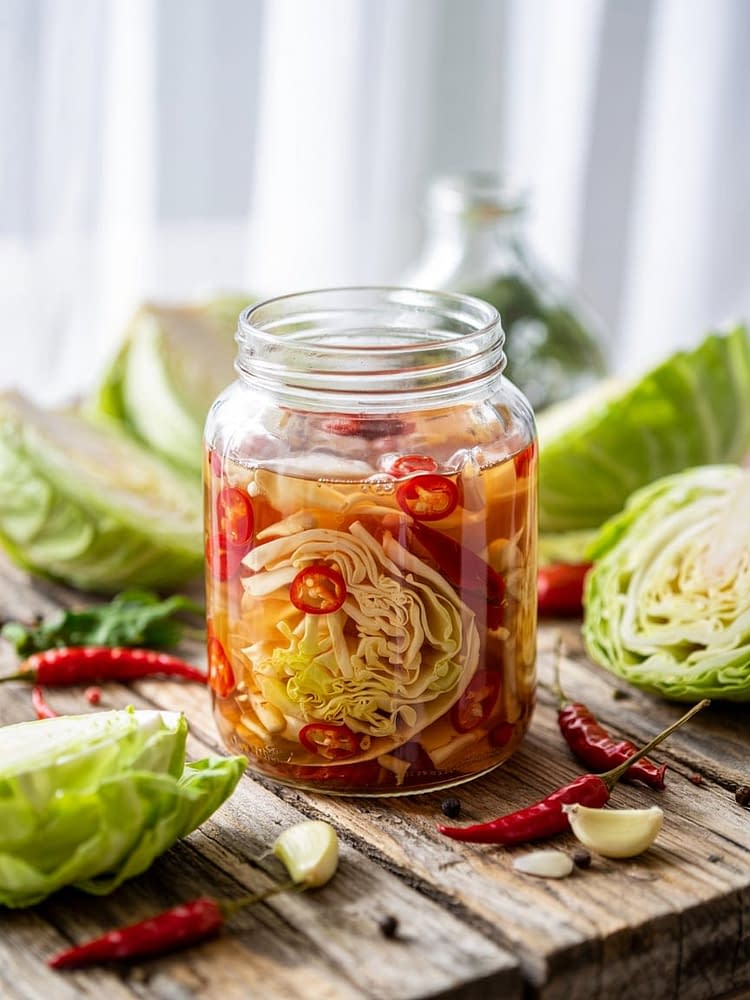Fermentation is one of the oldest and most reliable methods of food preservation, yet it continues to gain popularity today for its health benefits and unique flavor development. Among the many fermented foods, lacto-fermented cabbage with chili stands out for its delightful crunch, fiery kick, and gut-friendly properties.
This recipe combines the natural tanginess of lactic acid fermentation with the heat of fresh chilies, creating a condiment that’s as versatile as it is nutritious. Whether you’re looking to boost your probiotic intake, add zest to everyday meals, or simply explore traditional preservation techniques, this dish will not disappoint.
In this comprehensive guide, we’ll cover everything you need to know: from ingredients and step-by-step instructions to storage, variations, and expert fermentation tips. By the end, you’ll be fully equipped to make your own lacto-fermented cabbage with chili at home — with confidence and delicious results.
What is Lacto-Fermentation?
Before we jump into the recipe, let’s briefly explain what lacto-fermentation actually is.
Lacto-fermentation is a natural process where beneficial bacteria (primarily Lactobacillus) convert sugars in vegetables into lactic acid. This creates a tangy, slightly sour flavor while naturally preserving the food. No vinegar, heat, or artificial preservatives are required.
Key benefits of lacto-fermented foods:
- Probiotics: Supports gut health and digestion.
- Flavor: Develops complex tangy and savory notes.
- Shelf Life: Naturally preserved for months under refrigeration.
- Nutrient Boost: Fermentation often increases bioavailability of vitamins and minerals.
When cabbage is used, you may immediately think of sauerkraut or kimchi. This recipe, however, strikes a balance: it’s simpler than kimchi but more exciting than plain sauerkraut, thanks to the bold heat of chilies.
Ingredients for Lacto-Fermented Cabbage with Chili
Base Ingredients
- 1 medium cabbage (about 1 kg), finely shredded
- 20 g sea salt (non-iodized, about 2% of cabbage weight)
Flavoring Ingredients
- 2–3 fresh red chilies, thinly sliced (adjust to spice preference)
- 3 garlic cloves, sliced or lightly crushed
- 1 tsp fresh ginger, grated (optional for added warmth and aroma)
Fermentation Support
- 1–2 dried bay leaves (optional, helps maintain crispness)
- Filtered water (only if needed, to cover the cabbage completely)
Tip: Always use non-iodized salt and filtered water, as chlorine and additives can interfere with fermentation.
Step-by-Step Instructions
Step 1: Prepare the Cabbage
Remove the outer leaves of the cabbage and set them aside. Slice the cabbage finely using a sharp knife, mandoline, or food processor. The finer the shred, the quicker the fermentation.
Step 2: Salt and Massage
Transfer shredded cabbage into a large bowl and sprinkle evenly with sea salt. Massage with clean hands for 5–10 minutes until it begins to soften and release brine. This natural liquid will become your fermentation base.
Step 3: Add Flavorings
Mix in the sliced chilies, garlic, and ginger (if using). Ensure the seasonings are distributed throughout for an even flavor.
Step 4: Pack into the Jar
Pack the cabbage mixture tightly into a sterilized glass jar. Press down firmly with a wooden spoon or tamper to release more liquid. Continue until the cabbage is submerged in brine. If necessary, add a little filtered water to cover.
Step 5: Weigh Down and Seal
Place one of the reserved cabbage leaves on top to hold small bits under the brine. Add a fermentation weight or a small sterilized glass to keep everything submerged. Seal loosely with a fermentation lid, airlock, or cloth secured with a rubber band.
Step 6: Ferment at Room Temperature
Let the jar ferment at room temperature (18–22°C) for 7 days (168 hours). Check daily to ensure the cabbage stays submerged. You may notice bubbling, foam, or a tangy aroma — these are signs of healthy fermentation.
Step 7: Taste and Store
After 7 days, taste a small amount. If it has reached the tanginess you like, transfer to the refrigerator to slow fermentation. Stored properly, your lacto-fermented cabbage with chili will keep for 2–3 months.
Tips for Success
- Salt Ratio Matters: Stick to 2% salt by weight of the cabbage to ensure safety and proper fermentation.
- Avoid Metal Utensils: Use wooden or plastic spoons for packing and serving to prevent unwanted reactions.
- Patience Pays Off: Flavors deepen the longer you let it ferment. Taste at day 7, but it can be left for up to 10 days if you prefer a stronger tang.
- Keep it Submerged: Mold and spoilage happen when cabbage is exposed to air. Always keep it under brine.
- Temperature Control: If your kitchen is warmer, fermentation may complete faster (5–6 days). Cooler environments may take longer.
Variations to Try
- Carrot and Chili Cabbage: Add shredded carrots for sweetness and color.
- Radish Twist: Incorporate daikon radish slices for a Korean-inspired edge.
- Extra Heat: Use dried chili flakes or hotter peppers for a fiery version.
- Herbal Note: Add dill seeds or coriander seeds for a different aromatic layer.
- Kimchi-Style: For a more complex flavor, add fish sauce, scallions, and a touch of sugar.
Serving Suggestions
Lacto-fermented cabbage with chili is a versatile condiment. Here are some delicious ways to use it:
- With Rice or Noodles: Adds tangy crunch and heat to plain grains.
- Sandwiches & Wraps: Use as a topping to elevate flavor.
- Grilled Meats or BBQ: Complements smoky flavors beautifully.
- Breakfast Eggs: Pair with scrambled or fried eggs for a probiotic boost.
- Cheese Platters: Adds contrast to rich cheeses and charcuterie.
Storage & Shelf Life
Once refrigerated, your lacto-fermented cabbage with chili will last 2–3 months. Always use a clean utensil when serving to prevent contamination. Over time, flavors will continue to evolve but remain safe as long as it smells tangy, not rotten.
Signs to discard:
- Mold on the surface.
- Slimy texture.
- Foul, rotten odor (not the normal tangy smell).
Health Benefits
Including lacto-fermented cabbage with chili in your diet offers multiple benefits:
- Gut Health: Rich in beneficial probiotics that support digestion.
- Immune Support: Fermented vegetables may enhance immunity by improving gut microbiota.
- Nutrient Boost: Increased bioavailability of vitamin C, K, and B vitamins.
- Low-Calorie, High Flavor: A flavorful way to eat healthy without added fats or sugars.
Final Thoughts
Making lacto-fermented cabbage with chili at home is a rewarding process that connects you with traditional preservation methods while offering bold flavors and powerful health benefits. With just a few ingredients and a little patience, you can create a jar of probiotic-packed goodness that elevates everyday meals.
Whether you’re a fermentation beginner or an experienced home fermenter, this recipe strikes the perfect balance of tang, spice, and crunch. Try it once, and you’ll likely keep a jar in your fridge year-round.
Lacto-Fermented Cabbage with Chili Recipe
Lacto-fermented cabbage with chili is a tangy, probiotic-rich dish with a spicy kick that enhances flavor and gut health. This traditional fermentation technique uses natural lactic acid bacteria to preserve cabbage while deepening its flavor profile. Perfect as a condiment, side dish, or topping, this recipe delivers a crunchy texture and bold heat, making it a versatile addition to your meals.
Ingredients
For the Base:
For the Flavoring:
For Fermentation:
Instructions
Prepare the Cabbage
- Remove outer leaves of the cabbage and set aside (you’ll use them later). Shred the cabbage finely using a sharp knife, mandoline, or food processor.
Salt and Massage
- Place shredded cabbage in a large mixing bowl. Sprinkle sea salt evenly over the cabbage. Massage the cabbage firmly with clean hands for 5–10 minutes until it begins releasing water (the brine). The volume should reduce significantly, and the cabbage should feel soft.
Add Flavorings
- Mix in sliced chilies, garlic, and ginger. Ensure everything is evenly distributed through the salted cabbage.
Pack into Jar
- Transfer the cabbage mixture into a sterilized glass jar (mason jar or fermentation crock). Press down firmly with a wooden spoon or clean hand to pack the cabbage tightly and release more brine. The cabbage should be submerged under its own liquid. If not, add a little filtered water to cover it.
Weigh Down & Seal
- Place one of the reserved cabbage leaves over the surface of the packed cabbage to prevent small pieces from floating up. Add a fermentation weight or a small sterilized glass to keep the cabbage submerged. Seal the jar loosely with a fermentation lid or cloth cover with a rubber band (to allow gases to escape).
Fermentation
- Leave the jar at room temperature (18–22°C) away from direct sunlight for 5–10 days. Check daily to ensure the cabbage remains submerged in brine. If foam or bubbles form, this is normal. Taste after day 5 — when it reaches your desired tanginess, transfer to the refrigerator to slow fermentation.
Store and Enjoy
- Once refrigerated, the cabbage will continue to develop flavor slowly and can be stored for 2–3 months. Serve as a condiment with rice, noodles, grilled meats, or sandwiches.
Note
Storage: Store in the fridge for up to 2–3 months. Always use clean utensils when serving to avoid contamination.
Variations: Add shredded carrots, daikon radish, or green onions for extra flavor. For a kimchi-style variation, include fish sauce or soy sauce.
Salt Ratio Tip: Stick to 2% salt by weight (20 g per 1 kg of cabbage) to ensure safe fermentation. Too little salt may cause spoilage, too much will slow fermentation.
Fermentation Time: Warmer kitchens will ferment faster; cooler ones may take longer.








